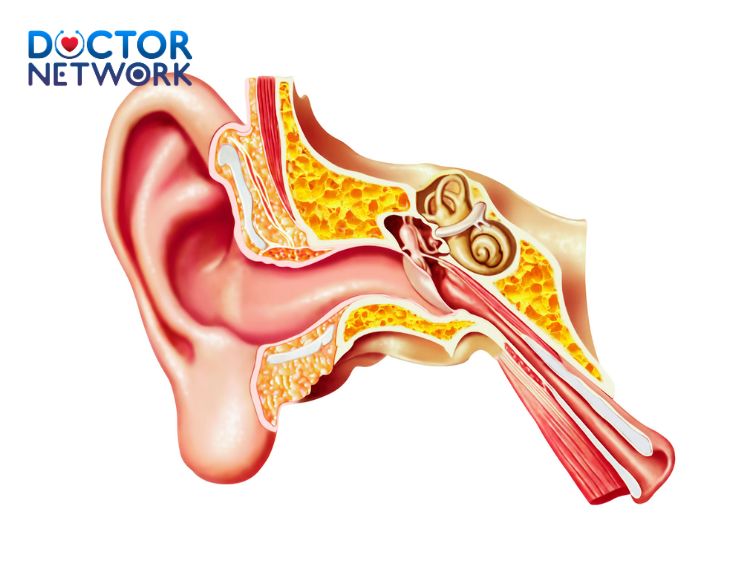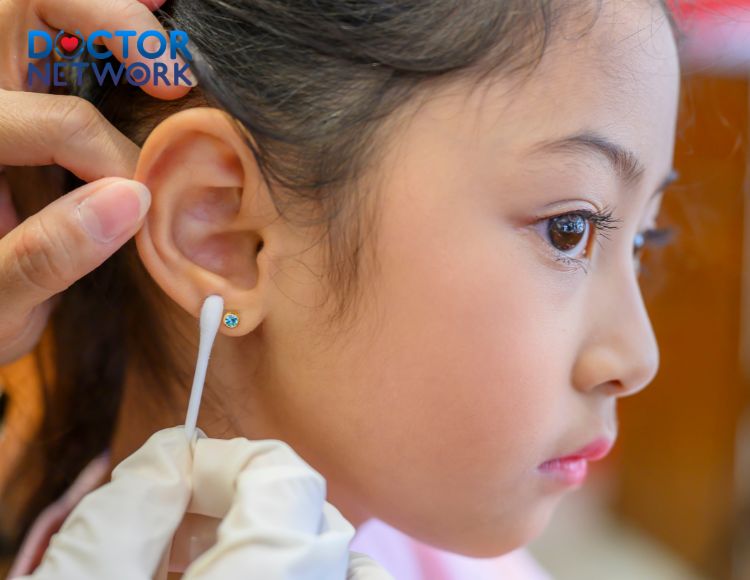What is a preauricular sinus? – A preauricular sinus is a benign congenital malformation that appears as a small hole in the skin near the front of the ear. Although this condition is not dangerous in most cases, it requires proper attention, especially in children, to prevent potential infections that could impact auditory health later on.

What is atrial fistula? – Atrial fistula is a benign birth defect
Causes of Preauricular Sinus
A preauricular sinus forms due to abnormalities during the embryonic development of the child. The ear undergoes a complex differentiation process from the branchial structures and clefts. If these structures do not close completely, an abnormal tract (preauricular sinus) can persist, connecting the skin in front of the ear to deeper tissues.

What is atrial fistula? – formed due to abnormalities in the child’s embryonic development stage
Symptoms and Manifestations of Preauricular Sinus
- Common Manifestation: A small hole (sinus tract) located in front of the ear, which may appear on one or both sides.
- Discharge: The preauricular sinus may sometimes secrete mucus or pus, especially when infected.
- Other Symptoms: Some cases may present with swelling, pain, and redness in the area in front of the ear, particularly when the preauricular sinus is infected.

What is atrial fistula? – A small hole (fistula) in front of the ear, can appear on one side or both sides
Diagnosis of Preauricular Sinus
Diagnosis of a preauricular sinus primarily involves:
- Clinical Examination: An ENT specialist will observe the patient’s ear and identify characteristics indicative of a preauricular sinus.
- Use of Dye: To determine the path of the preauricular sinus, the doctor may inject a special dye into the sinus tract.
- Imaging Techniques: In complex cases, a CT scan or MRI may be recommended to accurately assess the internal structure of the ear and identify the sinus tract’s location.
Treatment Methods for Preauricular Sinus
- Surgery: The primary method for definitively treating a preauricular sinus. The surgeon will remove the abnormal tract completely and reconstruct the affected ear area. Surgical success rates are relatively high, and children usually recover well after treatment.
- Conservative Treatment: In a few cases, conservative measures such as careful monitoring, maintaining hygiene of the sinus tract to prevent infection, and using antibiotics if secondary infections occur may be employed.
Potential Complications of Preauricular Sinus in Children
If untreated, a preauricular sinus can lead to several complications, including:
- Recurrent Infections: The sinus tract provides a favorable environment for bacterial growth, increasing the risk of frequent infections.
- Otitis Media: Infections from the sinus tract can spread to the middle ear.
- Abscess Formation: Severe infections can lead to abscess formation.
- Serious but Rare Complications: Some infections can spread to the brain (meningitis) or cause permanent hearing loss.
Prevention and Care for Preauricular Sinus
- Prevention: Since it is a congenital defect, complete prevention of preauricular sinus formation is challenging.
- Home Care: Maintain cleanliness around the sinus tract, avoid inserting objects into the sinus, and follow regular check-ups as scheduled by the doctor. Careful monitoring can help early detection and timely treatment of infections.
Advice for Parents of Children with Preauricular Sinus
Parents of children with a preauricular sinus should not worry excessively; most cases are treatable and do not affect the child’s development. Work closely with the doctor to choose the most appropriate treatment plan and ensure careful care to prevent infection complications.
Frequently Asked Questions about “What is a Preauricular Sinus?”
Here are five common questions related to the topic “What is a preauricular sinus?” along with their answers:
What are the common symptoms of a preauricular sinus?
- The most common symptom is a small, abnormal hole in the skin in front of the ear (preauricular sinus).
- This sinus can secrete mucus or pus, particularly when infected.
- In some cases, children may experience swelling, pain, and redness in the skin area in front of the ear.
Is a preauricular sinus a dangerous condition?
- Most cases of preauricular sinus are benign congenital malformations. However, if not properly cared for, recurrent infections can lead to complications such as otitis media, abscesses, and even hearing loss. Therefore, regular check-ups and monitoring by a specialist are essential.
Can a preauricular sinus heal on its own?
- A preauricular sinus is a congenital malformation and does not completely heal on its own. In some rare cases, the sinus tract might close, but the risk of infection and recurrence remains. Surgical removal of the tract is the definitive treatment.
Can a preauricular sinus be treated with medication?
- Medication, primarily antibiotics, is used to control infections in cases of an infected preauricular sinus.
- Surgical removal of the sinus tract is the main treatment to completely eliminate the sinus and reduce the risk of recurrence.
How should a child be cared for after preauricular sinus surgery?
- Keep the surgical site clean and change dressings according to the doctor’s instructions.
- Ensure the child takes prescribed medications and attends follow-up appointments as scheduled.
- Avoid trauma or vigorous activities that could impact the surgical site during the initial recovery period.
- Monitor for any abnormal signs such as high fever, excessive swelling, redness, or discharge from the ear and report these to the doctor immediately.
Scientific Evidence Related to “What is a Preauricular Sinus?”
Scientific Evidence about “What is a Preauricular Sinus?”
- Prevalence of Preauricular Sinus:
- According to research from the National Hospital of Pediatrics, the prevalence of preauricular sinus in Vietnamese children is approximately 0.04% – 0.06%.
- Another study at the Central General Hospital’s ENT Center showed a prevalence rate of 0.05%.
- Causes of Preauricular Sinus Formation:
- Research on the embryonic development of the ear indicates that preauricular sinus forms due to abnormalities in the closure of branchial clefts and structures.
- Some studies suggest that underlying genetic factors may increase the risk of developing a preauricular sinus.
- Treatment Methods for Preauricular Sinus:
- The effectiveness of preauricular sinus surgery has been demonstrated in numerous studies, showing high success rates and low recurrence rates.
- Some studies evaluating conservative treatment methods such as hygiene and antibiotics have shown limited effectiveness, suitable only for specific cases.
- Complications of Preauricular Sinus:
- Research indicates that if untreated, a preauricular sinus can lead to complications such as otitis media, abscess formation, and potentially affect hearing.
- The rate of complications is higher in children who do not receive treatment or are treated improperly.
Note:
The scientific evidence provided in this article is based on reputable sources; however, it is for reference purposes only and cannot replace professional medical diagnosis and treatment. Patients should consult with an ENT specialist for advice and treatment tailored to their specific condition.
References:
https://medlatec.vn/tin-tuc/ro-luan-nhi-la-gi-co-phai-la-benh-nguy-hiem-khong-s98-n31312
https://tamanhhospital.vn/ro-luan-nhi/
https://www.vinmec.com/vi/tin-tuc/thong-tin-suc-khoe/nhi/di-tat-ro-luan-nhi-khi-nao-can-phau-thuat/
Kiểm Duyệt Nội Dung
More than 10 years of marketing communications experience in the medical and health field.
Successfully deployed marketing communication activities, content development and social networking channels for hospital partners, clinics, doctors and medical professionals across the country.
More than 6 years of experience in organizing and producing leading prestigious medical programs in Vietnam, in collaboration with Ho Chi Minh City Television (HTV). Typical programs include Nhật Ký Blouse Trắng, Bác Sĩ Nói Gì, Alo Bác Sĩ Nghe, Nhật Ký Hạnh Phúc, Vui Khỏe Cùng Con, Bác Sỹ Mẹ, v.v.
Comprehensive cooperation with hundreds of hospitals and clinics, thousands of doctors and medical experts to join hands in building a medical content and service platform on the Doctor Network application.


























